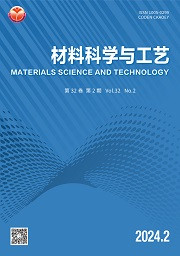| 引用本文: | 王礼凡,何平,韩理,胡海江.中碳合金钢奥氏体变形应力应变分析及屈服强度的预测[J].材料科学与工艺,2023,31(1):43-48.DOI:10.11951/j.issn.1005-0299.20220040. |
| WANG Lifan,HE Ping,HAN Li,HU Haijiang.Stress-strain analysis and yield strength prediction of austenite deformation of a medium carbon alloy steel[J].Materials Science and Technology,2023,31(1):43-48.DOI:10.11951/j.issn.1005-0299.20220040. |
|
| 摘要: |
| 奥氏体变形会影响合金钢中的相变和组织,奥氏体变形时的应力-应变影响因素比较复杂,涉及变形温度、应变速率甚至应变诱导相变的影响。本文以0.38C-1.44Si-0.82Mn-0.9Cr-0.25Mo-0.078V钢为对象,在Gleeble3500试验机上进行热模拟压缩变形实验,研究了不同变形温度下应力-应变的变化规律以及变形压缩样品的显微组织。结果表明,随着变形温度增加,应力逐渐降低,当变形温度为400 ℃时,因过冷奥氏体变形会诱发相变,产生了束状组织,导致应力随应变急剧增加,相较于其它较高温度的变形,呈现更大的加工硬化现象;此外,通过添加拟合参数对现有Medina模型和Eres-Castellanos模型进行拟合修正,使用修正后的模型计算本实验钢的屈服强度,结果表明其预测屈服强度与实际屈服强度基本吻合,建立了本实验钢奥氏体屈服强度预测模型,可以为其奥氏体变形工艺提供指导。 |
| 关键词: 过冷奥氏体 变形 应力 模型 屈服强度 |
| DOI:10.11951/j.issn.1005-0299.20220040 |
| 分类号:TB324; TQ33 |
| 文献标识码:A |
| 基金项目:国家自然科学基金资助项目(51704217, 51874216) |
|
| Stress-strain analysis and yield strength prediction of austenite deformation of a medium carbon alloy steel |
|
Lifan WANG, Ping HE, Li HAN, Haijiang HU
|
|
The State Key Laboratory of Refractories and Metallurgy (Wuhan University of Science and Technology), Wuhan 430081, China
|
| Abstract: |
| Austenite deformation can affect the transformation kinetics and microstructure of alloy steels. The factors influencing the stress-strain of austenite during deformation are complex, involving deformation temperature, strain rate, and strain-induced phase transformation. This research investigated the compression deformation behavior of 0.38C-1.44Si-0.82Mn-0.9Cr-0.25Mo-0.078V steel using Gleeble3500 thermal simulator. The variation of stress-strain at different deformation temperatures and the microstructure of deformed compressed specimens were studied. Results show that with the increase in deformation temperature, the stress gradually decreased. When the deformation temperature was 400 ℃, the undercooled austenite deformation induced phase transformation and produced rod-like microstructure, which resulted in a sharp increase in stress with strain, indicating a more obvious work-hardening phenomenon than other high temperature deformations. In addition, the existing Medina model and Eres-Castellanos model were modified by adding fitting parameters, and the yield strength of the experimental steel was calculated by using the modified model. Results show that the predicted yield strength was basically consistent with the actual yield strength. The yield strength prediction model of austenite of the experimental steel was established, which can provide guidance for austenite deformation process. |
| Key words: undercooled austenite deformation stress model yield strength |






